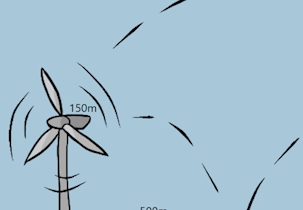Database on vegetation and wave noise enhances understanding of environmental noise
Research on vegetation and wave noise enhances understanding of rural environmental noise, aiding municipalities, developers, and researchers in addressing sound level regulation effectively.
Current noise regulation focuses primarily on absolute sound levels
In Denmark and several other nations, noise regulation mainly focuses on absolute sound levels rather than considering the audibility of specific noise sources. This approach introduces unique challenges, particularly concerning the deployment of wind turbines, which are commonly situated in rural areas.
Denmark's landscape is characterised by its flat topography and generally high population density. However, the rural regions stand out with lower population densities and greater distances between homes. This spatial distribution facilitates compliance with setback requirements and noise limitations designed for wind turbine installations. Moreover, these rural areas are often among the country's windiest, making them ideal for wind energy development. Additionally, Denmark's relatively extensive coastline—no point being more than 52 km from the sea—further enhances its suitability for harnessing wind energy.
Natural elements like waves and vegetation can mask other environmental noise, but this is unexplored
In these rural environments, common ambient noise sources include natural elements such as vegetation and wave activity. These sounds can effectively mask other environmental noise, which is crucial for understanding the acoustic landscape. However, the phenomenon of sound masking by vegetation and wave action remains underexplored in Denmark. Existing studies tend to document these effects only in relation to sound power level measurements for wind turbines, focusing predominantly on short-duration observations, often confined to hourly or daily time frames.
New database helps us better understand environmental noise dynamics in rural areas
This significant knowledge gap has been addressed through an EUDP-supported research project. Within this initiative, a key objective is to systematically gather and analyse vegetation and wave noise data. By developing simplified models that illustrate the relationship between these noise types and wind speed, the project aims to enhance our understanding of environmental noise dynamics in rural settings. The aggregation of both pre-existing and newly collected data provides valuable insights into the interactions between natural sound sources and human-made noise, contributing to filling the existing knowledge void.



Denmark and includes noise levels from natural sources like trees and waves.
Collected data fosters further research and promotes informed noise regulation and wind-energy decision-making
The data collected is publicly accessible and aims to improve regulatory frameworks and create a more comprehensive understanding of the acoustic environment, paving the way for sustainable wind energy development that harmonises with Denmark's natural landscape.
Downloads
See database
Database of vegetation noise and wave noise as a function of wind speed.






